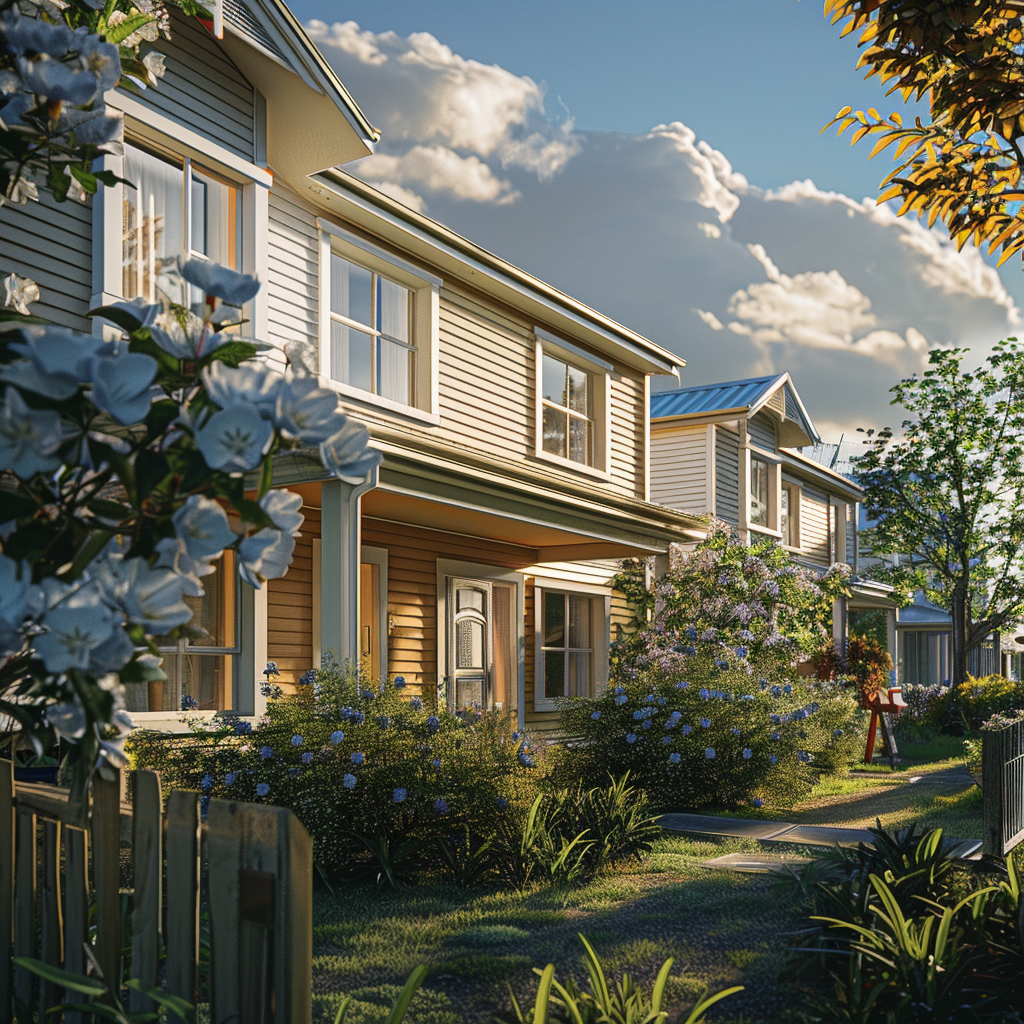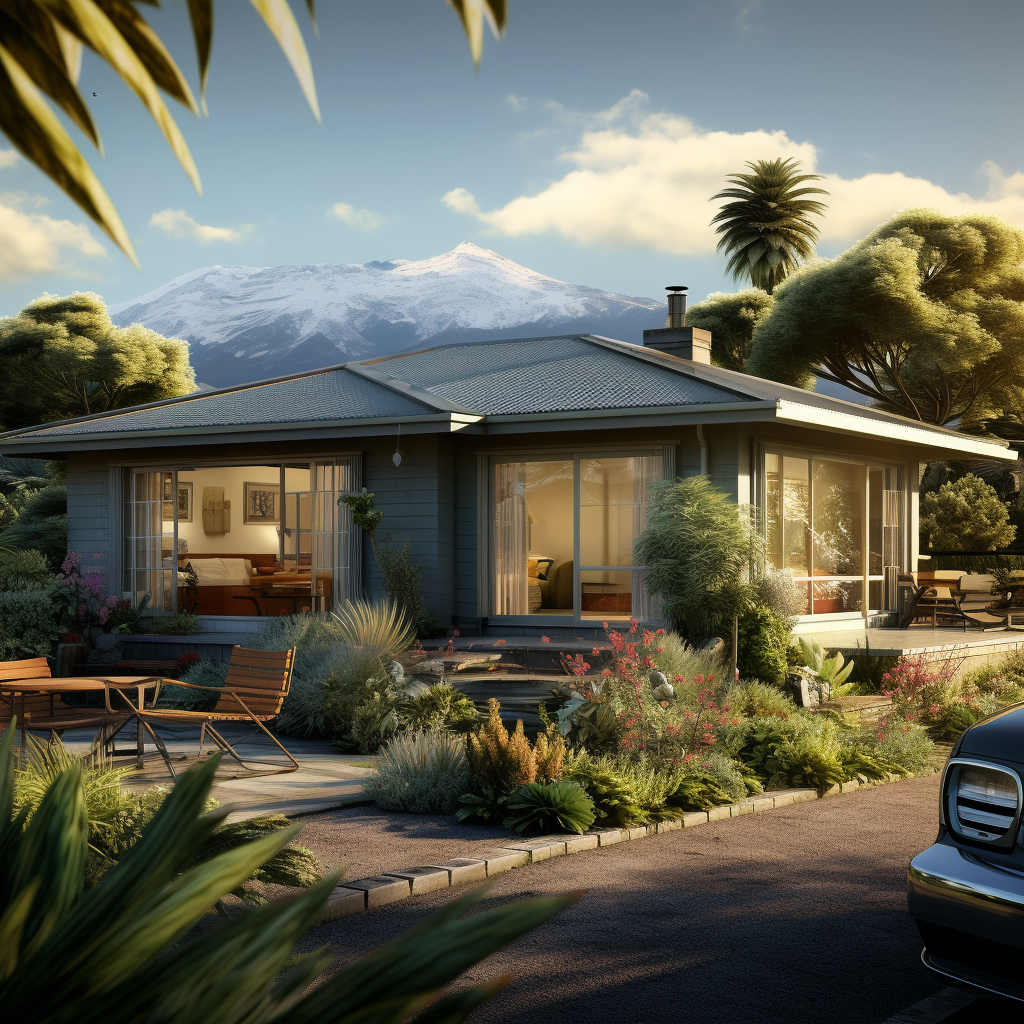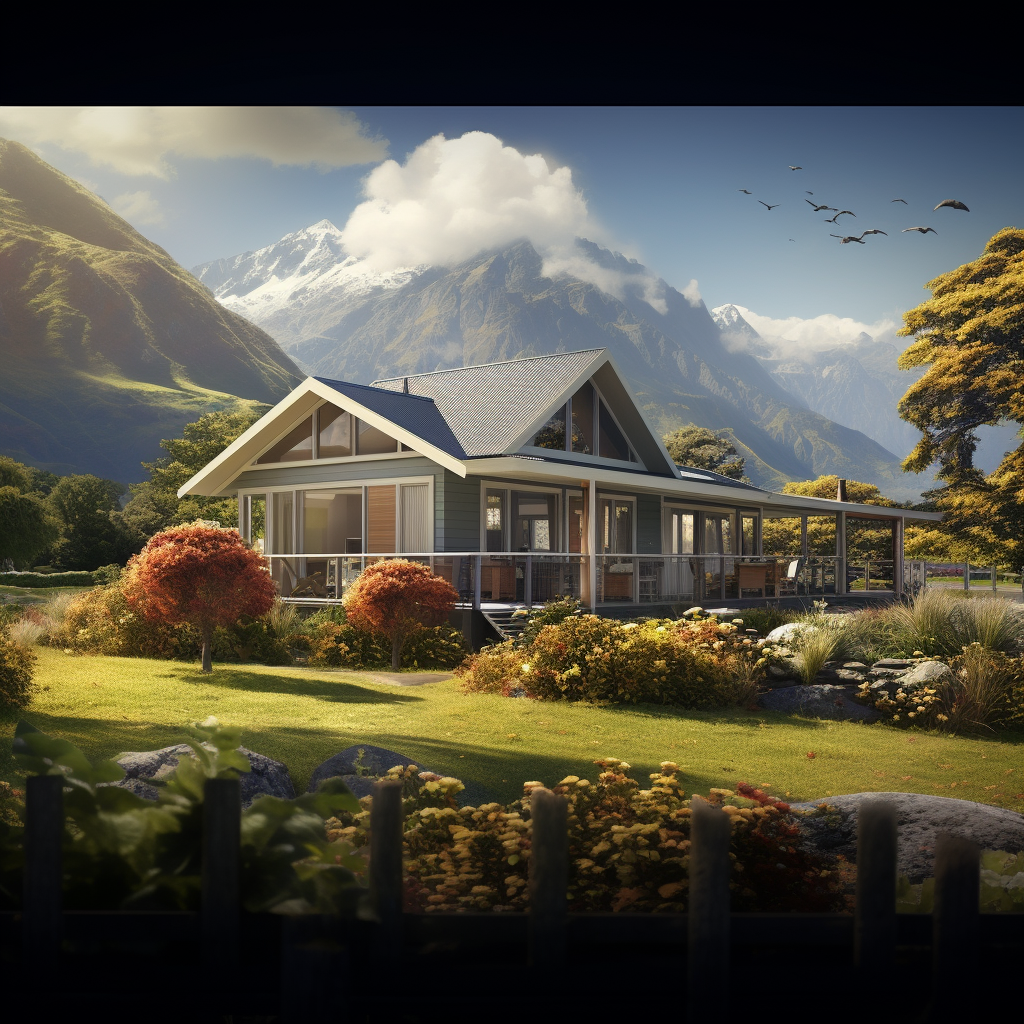Auckland's Blueprint for the Future: Unveiling the Core Pillars of the Unitary Plan
Introduction to the Auckland Unitary Plan
The Auckland Unitary Plan is more than just a document, it represents a vision for the city's future. As Auckland's strategic blueprint, it guides the development of the city, balancing rapid growth with the preservation of its unique heritage and natural environment.
This comprehensive plan serves a dual purpose:
- Managing Growth: It addresses the challenge of accommodating a rapidly expanding population, ensuring that growth is harmonised with the city's existing infrastructure and services.
- Preserving Heritage and Environment: The plan recognises the importance of preserving Auckland's rich heritage and natural environment in the face of urbanisation.
In short, the Auckland Unitary plan is a roadmap to a sustainable and inclusive future for all residents of Auckland.
The Paramount Role of Strategic Planning
Undeniably, cities experiencing exponential growth like Auckland require strategic planning to effectively cater to their expanding populations. In the absence of a comprehensive, well-thought-out plan, rapid growth could give rise to haphazard development. This can strain existing infrastructure, degrade precious natural resources, and adversely affect the quality of life for residents.
The Auckland Unitary Plan is a response to these potential challenges. It offers clear, practical guidelines for development that are designed to manage growth while still respecting Auckland's unique character. This strategic approach not only ensures orderly expansion but also:
- Enhances community cohesion,
- Fosters sustainable practices,
- Encourages cultural preservation.
By doing so, it maintains a balance between progress and preservation, ensuring that Auckland's growth is sustainable in every sense of the word.
Embracing Inclusivity: A Key Strength of the Plan
This strategic plan prides itself on its commitment to inclusivity. Recognising that residents have diverse needs and preferences, the Auckland Unitary Plan provides for a broad range of housing types and transport options. This inclusive approach allows Auckland to cater to all residents - regardless of age, income level or lifestyle preferences - creating an environment where everyone can thrive.
But it doesn't stop there. The Auckland Unitary Plan goes beyond physical infrastructure; it’s about building vibrant communities where people feel connected to their surroundings and each other. It seeks to promote social cohesion by fostering a sense of belonging among residents.
Striking a Balance: Growth and Preservation
Growth comes with its fair share of opportunities such as economic development and cultural diversity. However, it also presents challenges - how do we maintain Auckland’s distinctive character amidst rapid change? How do we ensure that historic buildings are preserved, natural landscapes safeguarded and local biodiversity protected?
The Auckland Unitary Plan addresses these concerns head-on. It integrates heritage preservation and environmental protection measures into its growth guidelines, ensuring that as Auckland grows, it doesn't lose its unique charm. This thoughtful approach allows Auckland to evolve while preserving the elements that make it a truly special place to live.
The Role of the Unitary Plan in Shaping Auckland's Development
The Auckland Unitary Plan is a crucial tool for shaping Auckland's development in a way that benefits current residents and future generations. By providing a clear framework for decision-making, it ensures growth is managed effectively and sustainably.
This strategic blueprint will influence everything from the design of new buildings to the layout of transport networks, creating a city that is functional, attractive and resilient.
Through the Auckland Unitary Plan, Auckland is set to become a city that not only embraces growth but also values its heritage and cherishes its natural environment. It represents an exciting step towards a sustainable and inclusive future for all residents.
Auckland Unitary Plan Zones
The Auckland Unitary Plan splits the city into different zones, each with its own set of rules. These zones help shape how Auckland will grow and develop by directing where certain activities can take place. Unitary Plan Zones are integral in managing growth and resource management.
Residential zones allow for homes of various densities, from single houses in suburban settings to high-density apartments in urban areas. Business zones provide for a range of commercial activities that support the economic wellbeing of the city. Rural zones, on the other hand, manage rural activities and protect the productive potential of rural land.
There are also Special Purpose Zones that cater to specific needs such as education facilities, healthcare services, or infrastructure. Lastly, the Open Space Zones ensure that ample recreational space is available for Auckland's residents.
Diverse as these zones may be, they work together towards a common goal – to create an Auckland that's well-planned and inclusive for everyone.
In-Depth Look at the Key Elements of the Auckland Unitary Plan
The Auckland Unitary Plan, a holistic approach to urban planning, is composed of several key elements. Each component plays an essential role in cultivating a sustainable, inclusive cityscape that caters to all residents of Auckland.
1. Housing Density Regulations
One of the most pressing issues in Auckland's growing population is finding the balance between accommodating this growth without compromising livability. The plan addresses this through Housing Density Regulations, which control the number of houses within specified areas. By doing so, it ensures that new developments do not put undue pressure on existing infrastructure or negatively impact the quality of life.
"Housing density regulations act as a check and balance system for urban development, ensuring growth is managed effectively."
2. Mixed Housing Urban Zones
Celebrating diversity is at the heart of the Auckland Unitary Plan. Mixed Housing Urban Zones are crafted to encourage an array of housing options, from standalone homes to terraced houses and low-rise apartments. The goal is to cultivate vibrant, inclusive communities that cater to diverse lifestyle choices and needs.
3. Building Height Restrictions
Sustainable growth requires harmony with the environment and an appreciation for visual aesthetics. With this in mind, Building Height Restrictions have been incorporated into the plan. These guidelines ensure that new developments seamlessly blend with their surroundings while preserving Auckland's unique skyline.
4. Heritage Protection Provisions
The Auckland Unitary Plan recognizes the importance of preserving Auckland's rich history and cultural identity through Heritage Protection Provisions. These safeguards protect significant historic sites, buildings, and landscapes, contributing to Auckland's unique sense of place and identity.
5. Public Transport Development
Recognising that a robust public transport system is crucial for a bustling metropolis like Auckland, Public Transport Development has been prioritised within the plan. Enhanced accessibility, reduced reliance on private vehicles, eased traffic congestion, and environmental preservation are all benefits of this focus.
6. Green Spaces
Green Spaces, integral parts of any urban landscape, provide both recreational areas and ecological benefits. They not only enhance Auckland's livability but also create essential habitats for local flora and fauna. Moreover, these green lungs contribute to climate change mitigation by providing cooling effects and improving air quality.
7. Affordable Housing Initiatives
The Auckland Unitary Plan also addresses the pressing issue of housing affordability in Auckland through Affordable Housing Initiatives. These initiatives ensure access to suitable housing for all residents, fostering inclusive communities where everyone can find a home, regardless of their income level.
8. Environmental Protection Measures
Lastly, the Environmental Protection Measures within the Auckland Unitary Plan aim to preserve natural resources, mitigate climate change impacts, and promote overall sustainability. These measures include protecting significant ecological areas and coastal environments, managing natural hazards and pollution.
Each aspect of the Auckland Unitary Plan works synergistically towards a shared objective - establishing a sustainable, inclusive future for all residents of Auckland. This strategic framework for urban planning propels Auckland on its path to becoming one of the world's most liveable cities.
Managing Urban Growth
Auckland's blueprint for the future includes a strategic approach to urban growth, ensuring that development is both sustainable and beneficial for current and future residents. The plan sets out to achieve this through several key initiatives, detailed below:
1. Rural Urban Boundary
This crucial demarcation is designed to contain urban sprawl, directing new housing and business developments to areas where they can be best supported by existing infrastructure. It delineates where the city ends and rural life begins, protecting valuable landscapes from being lost to unplanned developments.
2. Controlled Urban Expansion
To accommodate a growing population, Auckland must expand. However, this expansion is carefully managed to ensure that it aligns with the capacity of roads, utilities, schools, and healthcare facilities. This measured approach allows the city to grow without compromising the quality of services that residents rely on.
3. Infrastructure Development Plans
These are at the heart of supporting Auckland's growth. By enhancing transportation networks with more public transit options and bike paths, as well as upgrading utilities and community facilities, these plans aim to create a city that's not only bigger but better connected and more livable.
4. Urban Design Standards
These standards serve as a blueprint for beauty and functionality in new developments. They encourage innovative design that complements Auckland's character while promoting sustainability. Green buildings, public open spaces, and pedestrian-friendly layouts are all part of these holistic design considerations.
5. Climate Change Adaptation
Acknowledging the long-term impacts of climate change on coastal cities like Auckland, the plan incorporates adaptive strategies. From building sea walls to designing flood-resistant infrastructure, these measures aim to fortify Auckland against the effects of a changing climate.
6. Urban Intensification Areas
Selected areas within Auckland are earmarked for redevelopment and increased density. These intensification areas are near public transport hubs and amenities to support higher-density living—a move that aims to make efficient use of land and resources.
By addressing these aspects thoughtfully, Auckland's Unitary Plan lays a robust foundation for managing urban growth in a way that balances expansion with sustainability and resilience.
Promoting Connectivity and Engagement
Auckland's blueprint for the future places a high emphasis on transport corridors. These vital pathways are meticulously planned to bolster the city's transport network, ensuring that residents can move seamlessly between various areas.
Enhancing Transport Networks
Transport corridors serve as the backbone of Auckland's transportation strategy, enhancing the integration of public transport services with pedestrian and cycling infrastructure for a more efficient and sustainable transit system.
Partnering with Mana Whenua: A Pillar of the Unitary Plan
A critically important aspect of Auckland's Unitary Plan is its engagement with Mana Whenua. This reflects Auckland's unwavering commitment to form and maintain meaningful partnerships and conduct substantive consultations with Māori communities.
Upholding the Treaty of Waitangi Principles
The significance of this engagement process is underpinned by respect for the principles of the Treaty of Waitangi. This foundational document in New Zealand's history establishes a framework for partnership, participation, and protection among its signatories. The Unitary Plan honors these principles by:
- Partnership: Establishing a cooperative relationship between the Crown (government) and Māori with shared decision-making powers.
- Participation: Actively involving iwi (tribes) and hapū (sub-tribes) in land use and development processes.
- Protection: Ensuring Māori interests are safeguarded, focusing on their taonga (treasures).
"The engagement process respects the Treaty of Waitangi principles by actively involving iwi and hapū in shaping land use and development processes."
Embedding Māori Perspectives into Urban Development
This collaborative approach ensures that decisions made concerning urban planning and land use derive from a comprehensive understanding of the kinship between people and their environment.
By consciously embedding Māori perspectives, values, and knowledge into Auckland’s evolving landscape, the city can grow in ways that respect traditional connections to the land, promote cultural inclusivity, and enhance community resilience.
"Through this collaboration, decisions reflect a deep understanding of the relationship between people and their environment, embedding Māori perspectives and values into Auckland’s growing landscape."
In conclusion, through proactive engagement with Mana Whenua, Auckland's Unitary Plan not only adheres to treaty principles but also promotes a more inclusive, resilient, and culturally rich urban environment.
Adapting to Change
The dynamic nature of urban growth necessitates ongoing Unitary Plan monitoring and review. This iterative process ensures that the plan stays responsive to evolving conditions, societal shifts, and economic factors. By regularly revisiting and refining the plan, Auckland can adeptly manage change while keeping its strategic objectives aligned with residents' needs and aspirations. Regular updates also allow for incorporating innovative practices and emerging trends that contribute to a resilient and forward-thinking city.
By fostering connectivity through well-designed transport networks, honoring its cultural heritage through Mana Whenua engagement, and maintaining flexibility with regular reviews, Auckland is paving the way towards a cohesive urban environment where every resident can thrive.
Preserving Auckland's Heritage
Embedded in the heart of Auckland lies a treasure trove of cultural, historical, and architectural gems. Auckland's historic heritage is not only a testament to its rich past but also a vital part of the city's identity and sense of place.
From well-preserved Victorian-era buildings to sites steeped in Māori history, these heritage elements add layers to the city's story, providing a tangible link to its past. Recognising this, the Auckland Unitary Plan seeks to protect and preserve these irreplaceable assets.
Safeguarding Auckland's Historic Heritage
Contained within the plan are measures designed to safeguard Auckland's historic heritage for future generations:
- Advocating for careful management of any changes made to heritage sites
- Ensuring that their unique value is not lost or diminished
These provisions aim to strike a balance between development and preservation, allowing for progress while respecting the city's roots.
The Value of Preserving Heritage
The commitment to preserving Auckland's heritage is not just about protecting the city’s aesthetic appeal. It’s also about valuing the stories, traditions, and experiences that shape Auckland’s collective memory and identity. The Unitary Plan encapsulates this ethos by promoting sustainable growth while honoring the city's roots.
Exploring the Single House Zone
In the mosaic of Auckland's vibrant urban landscape, the Single House Zone stands out, playing a pivotal role. This zone is strategically designated within the Auckland Unitary Plan to preserve the charm of established neighborhoods while also accommodating controlled development. In this section, we delve deeper into the distinctive characteristics and meticulous regulations that define the Single House Zone, ensuring it aligns seamlessly with the broader objectives of Auckland's growth and development blueprint.
Unpacking the Characteristics of the Single House Zone
The Single House Zone, as its name implies, is primarily characterised by:
- Low-density residential areas: These areas emphasize spacious lots and a traditional suburban feel, where tranquility and privacy are premium.
- Detached houses: There is typically only one house per lot in this zone, maintaining a sense of openness and complementing the low-density nature of these areas.
- Building height restrictions: These restrictions ensure a harmonious streetscape, preserving sunlight access for residents and retaining the overall aesthetic appeal of the neighborhood.
Decoding the Objectives of the Single House Zone
The Auckland Unitary Plan outlines several key objectives for the Single House Zone, which include:
- Protecting amenity values: The plan seeks to protect aspects like outdoor space, privacy, and access to natural light that add to the overall quality of life in established residential areas.
- Maintaining character: The plan strives to retain distinctive architectural and historical elements that contribute to local identity in many neighborhoods within this zone.
- Controlled development: Recognising Auckland's growth needs, development within these areas is carefully managed so new buildings respect existing neighborhood patterns, ensuring a balanced evolution.
Understanding Development Controls in Place
To facilitate these objectives, specific controls have been established under the Auckland Unitary Plan for development within Single House Zones:
- Site size requirements: Minimum site size requirements are in place to promote lower density living, ensuring ample space for gardens and outdoor activities.
- Height in relation to boundary (HRB) standards: These controls dictate how close structures can be built to property boundaries, preserving privacy and reducing shadowing impacts between neighboring properties.
- Special character overlays: In areas with unique historical significance or architectural features, additional rules apply to protect these special character values.
Navigating Implications for Residents and Developers
For residents and developers seeking to build or alter homes within Single House Zones, understanding and navigating these regulations is critical. They must consider:
- Resource consents: Resource consents may be necessary for certain types of development that surpass 'permitted activity' standards. These are permissions required from local authorities before initiating certain developments.
- Neighborhood consultation: Early engagement with neighbors is beneficial in addressing any potential concerns regarding proposed developments, fostering a sense of community harmony.
- Professional advice: Taking advice from architects, planners, and legal professionals can offer invaluable guidance through the regulatory maze.
By adhering to these guidelines, any new developments within Single House Zones can contribute positively towards Auckland’s vision of sustainable growth without compromising the unique charm that makes these areas so appealing.
Low Density Residential Zone
The Low Density Residential Zone in Auckland's Unitary Plan is a pivotal component designed to delicately balance the need for growth with the desire to maintain spacious and tranquil suburban living. This zone plays a unique role in Auckland's wider housing tapestry, offering residents the opportunity to enjoy a relaxed lifestyle while still contributing to Auckland’s evolving urban landscape.
Understanding the Zone
In this zone, residential areas are characterised by:
- Detached single-family homes
- Generous spacing between properties
- Lower building heights compared to more urban zones
- A commitment to preserving the visual amenity and character of established neighbourhoods
Objectives of the Low Density Residential Zone
The primary aim here is to safeguard the low-intensity character of these areas. The rules and regulations governing this zone are carefully crafted to ensure developments are sympathetic to existing community attributes, including:
- Building Scale: Restrictions on building height and scale preserve sunlight access and privacy for neighbouring properties.
- Open Space: Requirements for outdoor space within each property support recreational activities and enhance neighbourhood greenery.
By maintaining lower-density housing, Auckland acknowledges the value of diversity within its urban fabric. Not everyone seeks the hustle and bustle of high-density living; some prefer the serenity that comes with more space and quieter streets.
Addressing Housing Needs
Despite its low-density nature, this zone is not immune to Auckland's housing challenges. It aims to contribute towards meeting housing needs by:
- Allowing minor units or secondary dwellings on larger sites
- Providing opportunities for subdivision, where appropriate, without compromising on zone objectives
These provisions enable subtle increases in housing supply while respecting the existing character of low-density neighbourhoods.
Integration with Broader Housing Strategies
While fostering lower density living environments, this zoning approach also aligns with broader strategies such as:
- Supporting housing options that cater to different lifestyles and preferences
- Encouraging sustainable development practices that complement Auckland's environmental goals
This integration ensures that low-density residential areas are not isolated but rather form part of a cohesive city-wide plan.
Impact on Community Development
Community development within these zones benefits from:
- Conservation of local character which strengthens community identity
- Promotion of neighbourly interaction through shared public spaces like parks and playgrounds
- Encouragement of active lifestyles with less-intensive land use allowing more space for gardens and outdoor activities
Residents can thus enjoy both personal space at home and a sense of belonging within their community.
Future Outlook
Looking ahead, this zone will continue to evolve in response to Auckland’s dynamic needs. Regular reviews of the Unitary Plan facilitate adaptations that may refine zoning provisions, ensuring they remain relevant and effective in nurturing balanced residential environments.
The Low Density Residential Zone stands as a testament to Auckland's dedication to provide varied living options. It acknowledges that quality of life is as much about environment as it is about accommodation, supporting a tailored approach where diversity in residential choices is celebrated. Moving forward into other zones reveals further layers of Auckland’s strategic vision for diverse yet harmonious urban growth.
Mixed Housing Suburban Zone: A Balanced Approach to Urban Planning
Auckland's Unitary Plan, a comprehensive framework for the city's future development, prominently features the Mixed Housing Suburban Zone. This strategic zoning approach is devised to support Auckland's booming population. It carefully balances the pressure of increased housing density with the innate desire for a suburban living environment that offers space and privacy.
The Mixed Housing Suburban Zone isn't merely an urban planning theory confined to policy documents. Rather, it breathes life into Auckland’s residential tapestry by allowing diverse housing options like detached houses, terraced housing, and low-rise apartments.
This zone stands out as it allows for a mix of various housing types within the same neighborhood. This means a single house might share its boundary with a duplex or an apartment building, creating a unique blend of built forms that cater to different housing needs and preferences.
Celebrating Housing Diversity
The Mixed Housing Suburban Zone sets its sights on promoting a variety of housing types, sizes, and costs. The strategy behind this is straightforward yet ingenious: by facilitating diverse housing options, we can accommodate a wider spectrum of residents.
Consider the following:
- Young professionals may lean towards apartment living close to public transport routes for easier commuting.
- Families might gravitate towards larger homes with private outdoor spaces where children can play safely.
- Older residents could prioritize smaller, low-maintenance properties close to essential amenities.
By fostering diversity in housing styles, the Mixed Housing Suburban Zone aims to build vibrant communities that mirror Auckland's rich demographic mosaic.
Striking a Balance between Density and Livability
While this zone actively encourages higher density living, it also places significant emphasis on preserving the existing character of an area. Key guidelines include:
- Ensuring new developments seamlessly blend with existing neighbourhood aesthetics.
- Limiting building heights to maintain sunlight access and uphold privacy for surrounding properties.
- Mandating the provision of adequate outdoor space for each dwelling.
These stipulations ensure that the push for higher density does not trample upon the living quality cherished by Auckland's residents.
Preparing for a Dynamic Future
The Mixed Housing Suburban Zone is not just about managing today's growth. It also lays a solid foundation for a future-ready Auckland. By allowing an assortment of housing types and densities, this zone paves the way for resilient communities that can easily adapt to future changes.
For instance:
- The rising median age in Auckland will likely lead to increased demand for smaller, more manageable homes.
- Changes in average household sizes may necessitate a greater supply of larger family homes.
- Persisting issues with housing affordability may drive popular preference towards higher-density options like apartments and terraced housing.
By encouraging a range of housing options within the same community, the Mixed Housing Suburban Zone stands ready to respond to these potential shifts in demand, ensuring Auckland remains an inclusive, vibrant city for generations to come. ".
Mixed Housing Urban Zone: Catering to Auckland's Evolving Housing Needs
As part of its comprehensive Unitary Plan, Auckland has introduced the Mixed Housing Urban Zone. This zone is a vital initiative aimed at addressing the city's pressing housing shortages and the growing demand for diverse accommodation alternatives. Covering a considerable portion of Auckland’s residential landscape, this zoning type allows for more intense development than its counterpart, the Mixed Housing Suburban Zone. The core objective is to effectively accommodate Auckland’s burgeoning population while promoting efficient utilisation of land resources.
Balancing High-Density Living with Variety: Housing Density and Typology
In the Mixed Housing Urban Zone, developers have greater flexibility to build high-density housing. They can construct three-storey dwellings, with no restrictions on density provided the site area exceeds 1,000 square meters. This provision encourages the creation of apartments, terraces, and various forms of multi-dwelling units to cater to fluctuating household sizes, diverse living preferences, and varying budget constraints.
Skyward Expansion: Building Height in the Urban Zone
A defining attribute of this zoning type is the allowable building height. Without requiring special approval, structures can reach up to 11m or span three storeys. This generous height allowance plays a significant role in accommodating more residents within a given unit area, thereby amplifying housing availability.
Quality Living through Open Spaces: Yards and Outdoor Living Space
Despite endorsing higher-density living, the Unitary Plan remains committed to ensuring residents' access to quality outdoor spaces. Specific criteria are set for yards and balconies in multi-dwelling developments:
- Front Yard: Developers must maintain a minimum distance of 2.5m from the road boundary.
- Side and Rear Yards: Buildings must be at least 1m away from the side or rear boundary.
- Outdoor Living Space: Dwellings with three or fewer bedrooms must include a minimum outdoor living space of 10m², with a minimum width of 2.5m.
Future-Ready Transport: Parking Provisions
In line with Auckland’s evolving transportation dynamics and the city's focus on encouraging public transit, cycling, and pedestrian routes, the Mixed Housing Urban Zone imposes no minimum parking requirements.
A New Chapter in Property Investment: Implications for Home Buyers and Investors
Properties within the Mixed Housing Urban Zone offer several advantages to potential home buyers. The vibrant urban lifestyle, proximity to amenities, and a plethora of housing options make it an attractive choice. Investors can also expect to benefit from the high demand for such urban living spaces.
However, understanding the potential implications of residing or investing in this zone is crucial. The increased housing density may impact privacy and lead to higher noise levels. There could also be additional pressures on existing infrastructure and services.
Harnessing Opportunities, Navigating Challenges: Implications for Developers
For developers, the Mixed Housing Urban Zone opens up possibilities to maximise land use. The absence of density control for larger sites offers avenues for profitable ventures. However, satisfying design requirements and managing potential community resistance to massive developments could present challenges.
Realtor.co.nz is dedicated to guiding property buyers, sellers, and developers through Auckland's intricate real estate landscape. Our extensive resources offer invaluable insights into every stage of your property journey.
The Mixed Housing Urban Zone is a bold strategy embedded within Auckland’s Unitary Plan. It embodies the city's commitment towards meeting its housing needs while championing sustainable urban development.
Terrace Housing and Apartment Zone: A Comprehensive Overview
In line with its innovative urban planning strategy, The Auckland Unitary Plan has acknowledged a crucial zone, the "Terrace Housing and Apartment Zone" (THAZ). This zoning classification carries significant weight in Auckland's future development blueprint. Its core objective is to promote high-density residential areas while ensuring residents' access to essential services and efficient public transportation systems.
Understanding the Specifics of Terrace Housing and Apartment Zone
THAZs are strategically positioned in vibrant urban areas that offer excellent connectivity to public transport, a plethora of employment opportunities, and a wide array of services. This zone permits an extensive range of residential accommodation types, including terrace houses and low- to high-rise apartment buildings, thereby catering to diverse lifestyle preferences and needs.
Interesting Fact: THAZs are intentionally situated around major transport nodes or along critical arterial routes. This strategic location aims to encourage the use of public transport over private vehicles, thus promoting sustainable living practices.
Decoding Building Regulations in Terrace Housing and Apartment Zone
In the THAZ, developers are required to adhere to certain building regulations designed to maintain high living standards. These regulations take into account factors such as privacy, access to natural light, and impact on adjacent properties:
- Building Height: The maximum permissible height ranges from 16 metres (approximately five storeys) up to a towering 72.5 metres (around 20 storeys), based on the specific location within the zone.
- Yard Requirements: For sites that front arterial roads, there’s a mandatory 5 metres front yard requirement.
- Outlook Space: Each main living room should have an outlook space spanning at least 6 metres in all directions.
- Site Coverage: Developers are allowed to cover up to 50% of the total site area with their constructions.
Exploring the Benefits of Living in Terrace Housing and Apartment Zone
Residing in a THAZ offers numerous advantages, all designed to elevate the quality of urban living:
- Unmatched Accessibility: These zones are usually situated near key amenities like shops, workplaces, schools, parks, and other facilities, which facilitates convenience for daily errands and activities.
- Housing Diversity: With options ranging from terraced houses to apartments, residents have the flexibility to choose a home that aligns with their unique lifestyle needs and preferences.
- Efficient Public Transport: The close proximity of THAZs to major transport hubs simplifies commuting.
- Dynamic Community: High-density living can foster a robust sense of community, encouraging frequent social interaction amongst residents.
Influence on Auckland's Housing Market
The incorporation of THAZ in the Auckland Unitary Plan has led to an increase in the variety of high-quality, high-density housing options available in the city. This not only caters to the housing demand but also plays a significant role in Auckland's urban regeneration.
Did you know? According to realtor.co.nz, properties within THAZ have witnessed considerable value growth due to their strategic location and heightened demand.
In summary, the Terrace Housing and Apartment Zone is a progressive aspect of the Auckland Unitary Plan that champions sustainable urban growth while offering an array of housing options. By balancing population density with quality of life, this zone holds the potential to transform Auckland's urban landscape. ".
Mixed Use, General Use and Business Park Zones
Auckland's Unitary Plan recognises the need for versatile spaces that cater to the dynamic interplay between residential life, business activity, and commercial services. The inclusion of mixed use, general use, and business park zones within the plan reflects a forward-thinking approach to urban development. These zones are key components of Auckland's strategic vision, fostering environments where people can live, work and play in close proximity.
Mixed Use Zones
In mixed use zones, the goal is to create vibrant communities with a seamless blend of residential apartments, retail outlets, offices, and sometimes light industrial activities. These areas are often located along major transport routes, contributing to reduced commute times and increased accessibility to essential services.
- Diversity of Architectural Styles: A mix of building types and designs are encouraged to cultivate a rich urban character.
- Live-Work Opportunities: By combining residential spaces with commercial premises, these zones offer the convenience of living near one's place of work.
- Community Vibrancy: Retail and hospitality at ground level activate street fronts, creating bustling public realms.
General Use Zones
General use zones provide a flexible framework that can accommodate a broad range of activities without strict controls over land use. This adaptability is particularly beneficial for developing areas where future needs may be uncertain or evolving.
- Adaptive Land Use: Flexibility for businesses to expand or change operations without extensive rezoning processes.
- Innovative Approaches: Entrepreneurs and developers are encouraged to bring novel concepts to fruition, enhancing economic vitality.
- Ease for Businesses: Reduced regulatory barriers support business growth and employment opportunities.
Business Park Zones: An Overview
Business park zones are meticulously designed spaces that are intended to provide an optimal environment for businesses and their employees. The primary focus while designing these zones is to create high-quality working environments that not only attract talented professionals but also inspire them to stay.
These zones cleverly combine the functionality of office space with light industrial facilities. Furthermore, they are often set in beautifully landscaped settings, showcasing a commitment to sustainability and employee well-being.
Key Features of Business Park Zones
Sustainable Design Principles
One of the integral features of business park zones is their adherence to sustainable design principles. The buildings within these zones are constructed based on energy-efficient models. This not only reduces operational costs but also contributes to Auckland’s green infrastructure network, thereby creating a balance between urban development and environmental preservation.
The inclusion of green spaces in these zones further enhances their sustainability quotient. These areas not only provide relaxation spots for employees but also help in maintaining local biodiversity.
High-Quality Work Environments
Another distinguishing feature of business park zones is the emphasis on creating high-quality work environments. These zones are equipped with a variety of amenities such as cafes, childcare centres, and gyms that cater to the diverse needs of the employees.
By offering these facilities within the premises, business park zones promote a balanced work-life culture. This holistic approach towards employee well-being helps increase productivity and boosts employee satisfaction levels.
Economic Clusters
The strategic grouping of related industries within business parks facilitates collaboration and innovation within sectors. This concept, known as economic clustering, encourages knowledge sharing and synergistic growth among businesses.
Economic clusters facilitate networking among professionals, fostering a culture of collaboration and mutual growth. By bringing together companies from related industries, these parks encourage innovation and help businesses stay competitive in their respective fields.
- In conclusion, business park zones represent a modern approach towards urban planning that integrates efficient use of space with sustainable practices and employee well-being. As a result, they have become an integral part of Auckland’s urban landscape.
Implementation in Auckland
Specific examples in Auckland where mixed use, general use and business park zones have been successfully implemented include:
- Wynyard Quarter: A waterfront precinct transformed into a mixed-use area combining modern offices, restaurants, public spaces and residential developments.
- Smales Farm on Auckland’s North Shore: A cutting-edge business park zone offering smart office buildings with community events and modern amenities.
Contribution to Auckland’s Growth
These diverse zoning categories contribute significantly to Auckland's growth by:
- Encouraging Efficient Land Use: Optimal utilisation of space meets multiple needs within compact footprints.
- Facilitating Economic Development: Business-friendly environments stimulate job creation and attract investments.
- Enhancing Quality of Life: Integrated living solutions reduce reliance on vehicles, lowering emissions and promoting healthier lifestyles.
Mixed use, general use and business park zones are integral pillars of the Unitary Plan's blueprint for Auckland. They exemplify how thoughtful urban planning can yield multifaceted benefits for residents while maintaining the city's competitive edge as a desirable place for businesses to thrive. For those navigating property transactions in these areas—whether buying or selling—realtor.co.nz serves as an invaluable resource throughout this complex journey. With comprehensive advice tailored specifically for New Zealanders’ property needs, it ensures informed decision-making every step of the way.
The Three Things That Investors Should Know About The Unitary Plan
For international investors looking to capitalise on the Auckland real estate market, the Auckland Unitary Plan serves as a comprehensive blueprint. It not only outlines the city's growth strategy but also unveils a plethora of investment opportunities. Let’s dive into three crucial points that overseas investors should be aware of:
- Investing in High-Density Developments: The Unitary Plan underscores the need for increased housing density, particularly in and around transport hubs and urban centres. This emphasis translates into lucrative investment avenues for overseas patrons. Property types like multi-unit developments—apartments and terraced houses—are gaining prominence under this plan to cater to Auckland's burgeoning population needs. The strategic shift towards compact city living ushers in opportunities for developments tailored for diverse demographics. For instance, young professionals, singles, and smaller households who prefer easy access to amenities and public transport.
- Capitalising on Affordable and Mixed Housing: A key aspect of the plan is its focus on affordable housing provision and mixed housing urban zones to foster diverse, inclusive communities. This focus signals a robust market for developments offering an array of housing options at varied price ranges catering to a broad cross-section of the population. Investments that resonate with the plan's goals of providing affordable and assorted housing types are likely to receive backing from local planning authorities. This support could potentially expedite the consenting process.
- Embracing Sustainable and Eco-friendly Developments: Environmental protection and sustainability are at the heart of the Unitary Plan, which includes strategies for adapting to climate change and augmenting green spaces. Investments in developments prioritising eco-friendly design, construction practices, and contributions to the city’s green infrastructure align with the plan’s vision, enhancing their appeal to Auckland's buyers and renters alike. Projects embedding sustainable features—such as energy efficiency, water conservation measures, and integration with public transport networks—are primed to meet future demands as Auckland strides towards an eco-conscious future.
Remember, the Auckland Unitary Plan is not just a city development framework— it's a guide to investment opportunities that could yield significant returns. As an overseas investor, understanding these key aspects of the plan could help you make informed decisions and maximise your investment in the Auckland property market.






